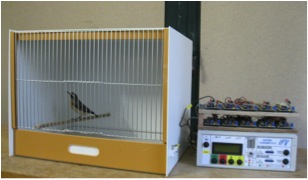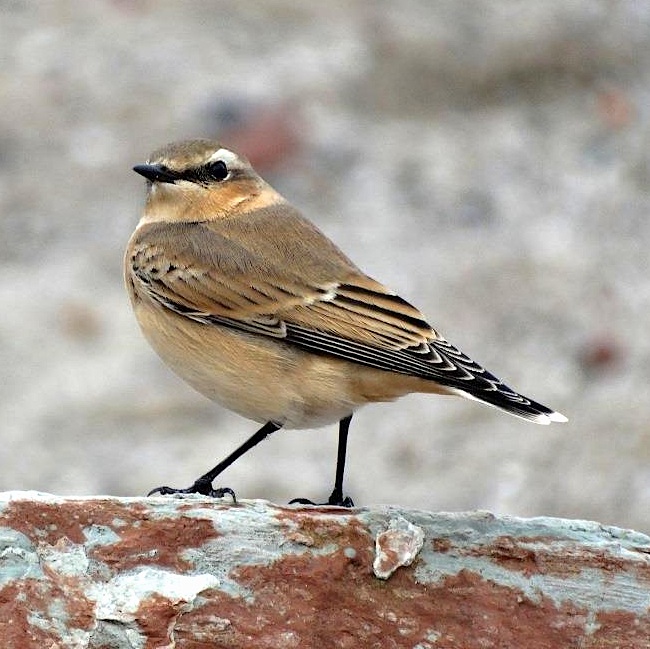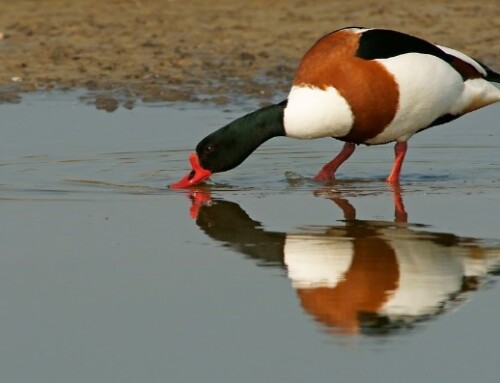How do wind conditions influence the temporal schedule of bird migration?
Linked IBIS paper
Wind conditions experienced during the day predict nocturnal restlessness in a migratory songbird . Cas Eikenaar & Heiko Schmaljohann. IBIS. DOI: 10.1111/ibi.12210
Wind conditions influence the temporal schedule of bird migration, but how the strength of this effect varies with geographical location, time in the migration season and species is unknown. We developed a novel and cheap approach that allows investigation of such variation.
The time it takes birds to complete their migrations between the breeding and wintering grounds is strongly influenced by weather conditions encountered along the way. Weather, especially precipitation and wind conditions, can affect migration speed in two ways. First, weather can directly slow down migrants if they, for example, face headwinds while on the wing, or drift from their optimal route due to strong sidewinds (Liechti 2006). Second, adverse weather can delay migration because it discourages birds to depart from stopover sites, which migrants use to replenish the fuel used in flight. Because the time migrants spend at stopover sites by far exceeds the time in actual flight (e.g. Schmaljohann et al. 2012), length of stopovers to a large extent determines overall migration time.
Most studies investigating the effect of wind on departure likelihood suggest that migrants favor departing from stopover sites in tailwinds over departing in strong side- or headwinds (e.g. Åkesson & Hedenström 2000; Dierschke & Delingat 2001), but exceptions exist (e.g. Thorup et al. 2006; Schmaljohann et al. 2013).
Unfortunately, accurately determining whether or not a migrant has departed is very difficult. At present the most reliable methods to study the effect of wind conditions on departure likelihood are large-scale automatic radio-tracking systems, and radio-tracking at isolated stopover sites (e.g. small islands) which preclude landing shortly after true departure. The disadvantages of these methods are that they are costly and stationary (cannot be easily moved), and consequently limited in their geographic extent. We used a novel, cheap approach to study the effect of wind conditions on departure likelihood at stopover that does not face these issues.
Using Northern Wheatears (Oenanthe oenanthe) caught at stopover on the island of Helgoland, we approximated migrants’ propensity to depart by measuring their nocturnal migratory restlessness (“Zugunruhe”) the night following capture (Figure 1). Migratory restlessness occurs when birds in migratory disposition are caged, and mainly consists of wing fluttering while perched (Berthold et al. 2000; pers. obs.). Importantly, we recently showed that migratory restlessness is an accurate proxy for a bird’s motivation to depart from stopover (Eikenaar et al. 2014). Since wind conditions often are highly auto-correlated on a daily scale, migrants may use day-time wind conditions (i.e. at the time of their capture) to predict the wind conditions at night (i.e. at their potential departure time).

Figure 1. A Northern Wheatear in a registration cage. Migratory restlessness is recorded automatically with a motion-sensitive microphone (attached to the cage wall). Each time a bird moves this generates an impulse that is transmitted to the recording devices.
We found a positive effect of wind conditions at the time of capture on the intensity of migratory restlessness in the night following capture (Figure 2), suggesting that departure likelihood increased with increasing wind support towards the migratory goal. This result matches the general trend from previous research, indicating that measuring nocturnal migratory restlessness is a reliable method to study the effect that wind conditions experienced at stopover have on the departure decision of migrants. This result also shows that migrants appear to possess the ability to consider environmental conditions experienced during the day in their departure decisions at night.
Figure 2. The effects of surface wind profit at capture on migratory restlessness the night following capture in Northern Wheatears during stopover on Helgoland (n = 89). A positive value of wind profit means that birds experienced wind support towards their migratory goal.
Our approach is straightforward and affordable; required materials are a room that can be darkened, bird cages and a device to measure nocturnal migratory restlessness (Figure 1). Therefore, it is well suited to investigate the effect of wind on the scheduling of stopovers on a large spatiotemporal scale. For example, we expect that migrants facing an ecological barrier need to be highly wind selective to stand a chance at successfully crossing the hostile stretch. When no barrier is to be crossed, wind selectivity is expected to be less important, but no large-scale comparison has been made to test this hypothesis. We also expect that migrants travelling late in the season cannot afford to wait too long for favorable winds to come up, as this might prevent them from finding mates for reproduction at the breeding area. In contrast, early in the season it might pay off to wait a certain time for favorable winds, as exploiting them might considerably speed up migration.
References
Åkesson, S. and Hedenström, A. (2000). Wind selectivity of migratory flight departures in birds. Behav. Ecol. Sociobiol. 47, 140-144. View
Berthold, P., Fiedler, W. & Querner, U. (2000). Die Zugunruhe bei Vögeln – eine Darstellung nach Videoaufnahmen bei Infrarotlichtbeleuchtung. J. Ornithol. 141, 285-299. View
Dierschke, V. and Delingat, J. (2001). Stopover behaviour and departure decision of northern wheatears, Oenanthe oenanthe, facing different onward non-stop flight distances. Behav. Ecol. Sociobiol. 50, 535-545. View
Eikenaar, C., Klinner, T., Szostek, K. L. & Bairlein, F. (2014). Migratory restlessness in captive individuals predicts actual departure in the wild. Biol. Lett. 10: 20140154. View
Liechti, F. (2006). Birds: blowin’ by the wind? J. Ornithol. 147, 202-211.View
Schmaljohann, H., Fox, J. W. & Bairlein, F. (2012). Phenotypic response to environmental cues, orientation and migration costs in songbirds flying halfway around the world. Anim. Behav. 84, 623-640. View
Schmaljohann, H., Korner-Nievergelt, F., Naef-Daenzer, B., Nagel, R., Maggini, I., Bulte, M. & Bairlein, F. (2013). Stopover optimization in a long-distance migrant: the role of fuel load and nocturnal take-off time in Alaskan northern wheatears (Oenanthe oenanthe). Front. Zool. 10. View
Thorup, K., Alerstam, T., Hake, M. & Kjellén, N. (2006). Traveling or stopping of migrating birds in relation to wind: an illustration for the osprey. Behav. Ecol. 17, 497-502. View
If you want to write about your research in #theBOUblog, then please see here.






